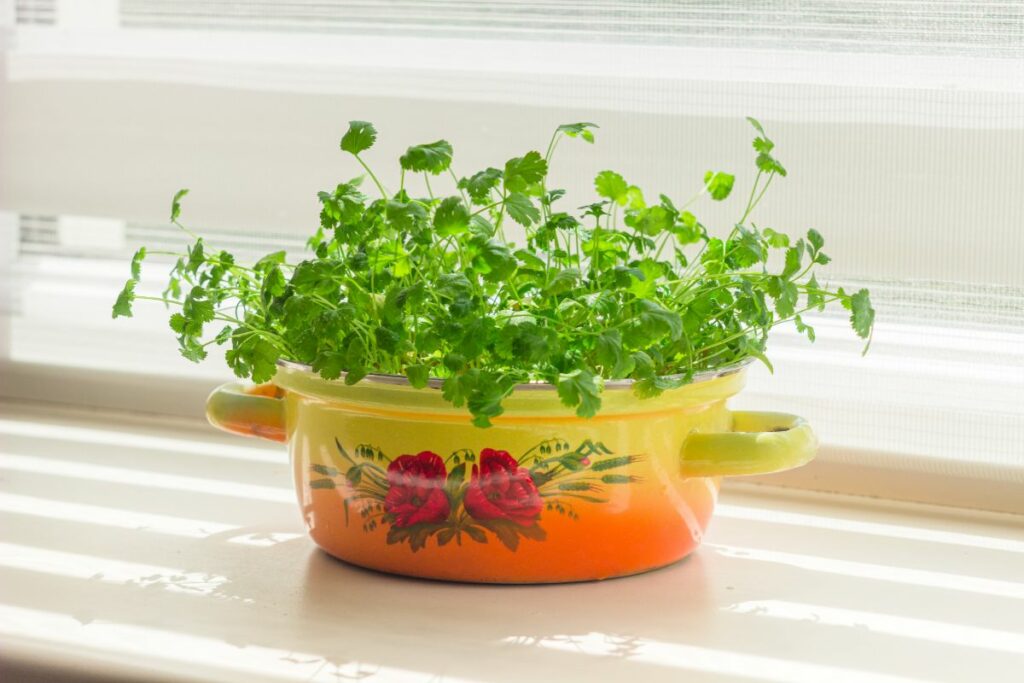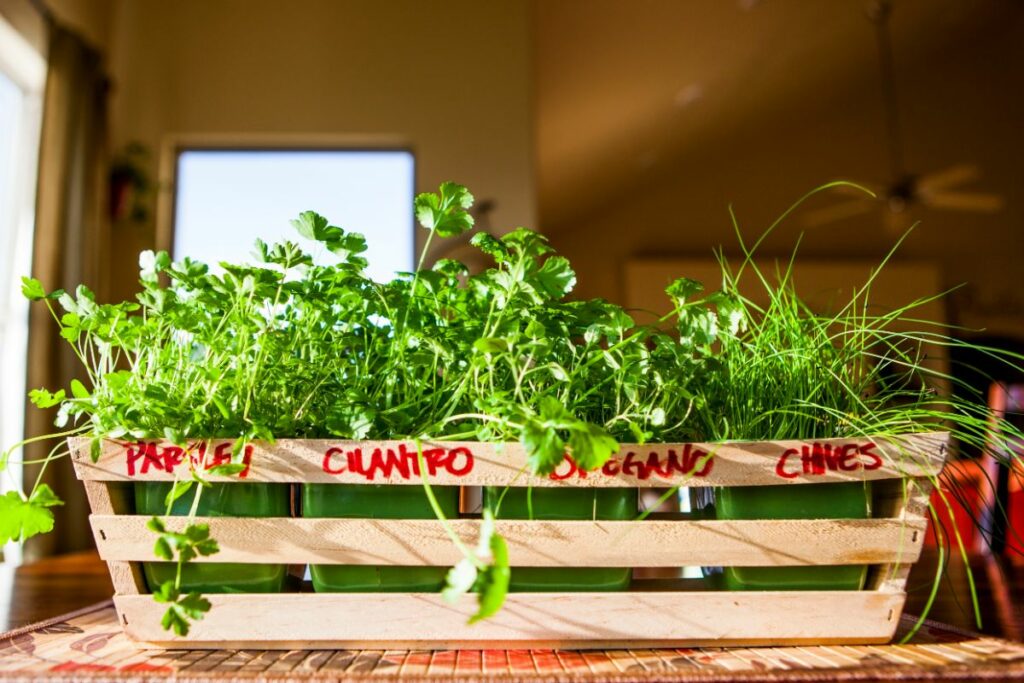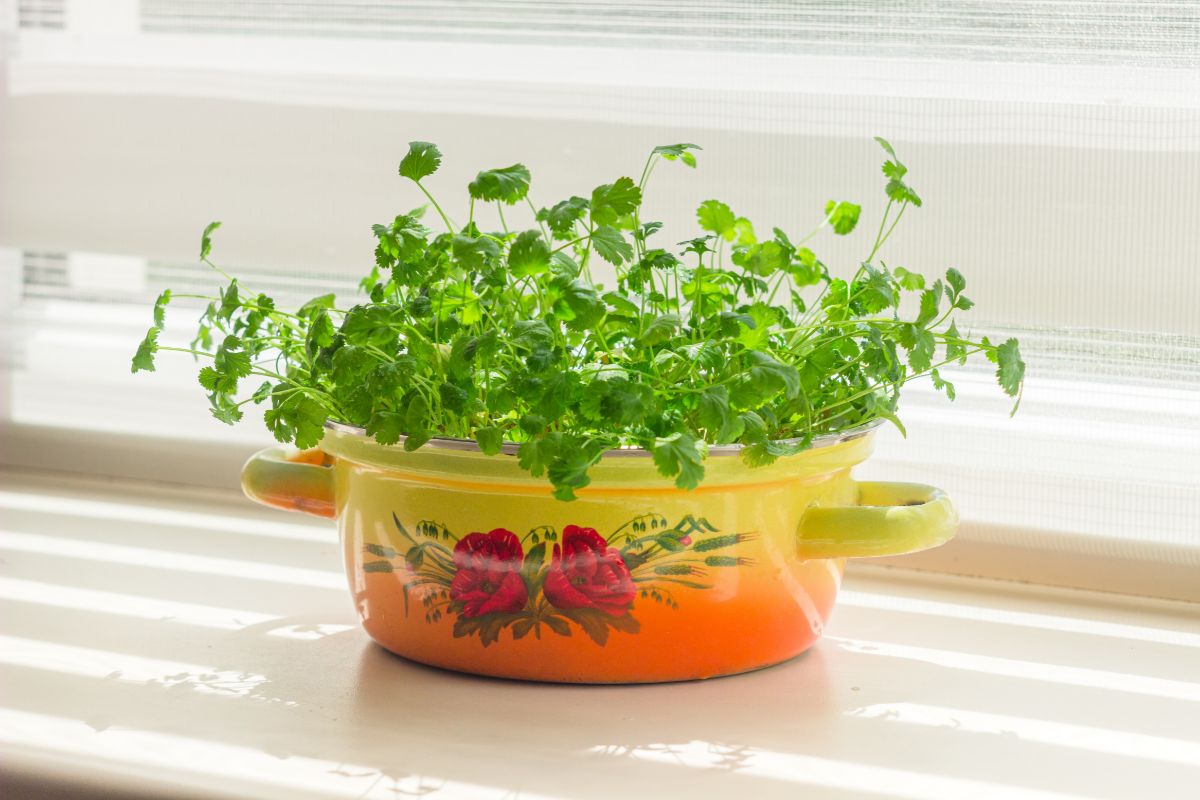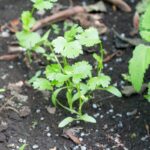Growing herbs indoors is both practical and rewarding, and cilantro is an excellent choice for indoor cultivation.
This aromatic herb is used in a variety of cuisines and is revered for its distinct flavour.

Here’s how you can successfully grow cilantro indoors, from start to finish.
Equipment And Supplies
Before you begin, gather all the necessary equipment and supplies. Here’s a more detailed look at what you’ll need:
- Potting Containers: Opt for containers that are at least 8 inches deep and 6-8 inches in diameter. The containers must have drainage holes to prevent root rot. Terra-cotta pots are an excellent choice as they allow the soil to breathe.
- High-Quality Potting Soil: Choose an organic, well-draining soil mix. Some potting mixes come fortified with time-released fertilisers, providing your cilantro with a good start.
- Cilantro Seeds or Seedlings: While both are viable options, seeds are more commonly used for cilantro due to its delicate, hard-to-transplant root system.
- Liquid Fertiliser: Opt for an organic liquid fertiliser that’s formulated for edible plants. You can also make your own compost tea if you’re into organic gardening.
- Grow Lights: These are optional but highly recommended if you don’t have access to adequate natural light.
We’ve already discussed the basics, but let’s consider some optional but beneficial tools:
- Thermometer and Humidity Meter: These instruments can help you keep track of environmental conditions.
- Watering Can with a Fine Rose: A finer spray can help ensure that you moisten the soil without flooding it, which is especially important for seed germination.
Step 1: Choosing Containers and Soil
Selecting the right container and soil isn’t just about aesthetics; it can affect the overall health of your cilantro plant.
Start by selecting a container that’s at least 8 inches deep to accommodate the cilantro’s long taproot.
Make sure the container has drainage holes to prevent waterlogging.
Fill the container with high-quality potting soil; avoid garden soil, as it can contain pests and diseases.
Cilantro prefers slightly acidic to neutral soil, with a pH range of 6.0 to 7.0. If you find that your soil is too alkaline or too acidic, amendments can be made to adjust its pH.
A layer of small stones or broken terracotta pieces at the bottom can further assist with drainage.
Step 2: Planting the Seeds
Scatter the cilantro seeds evenly across the soil surface. Gently press the seeds into the soil, but don’t bury them deep, as they need light to germinate.
Planting depth is crucial for seed germination. Cilantro seeds need to be close to the soil surface to receive enough light for germination.
Plant multiple seeds per container to ensure a lush, full-grown plant. Space them about 1 inch apart to give each seed room to grow.
Cover the container with a thin layer of soil or vermiculite. Water the soil lightly to moisten it.
The typical time for cilantro seeds to germinate is between 7-10 days. During this period, keep the soil consistently moist but not waterlogged.
Top tip: To speed up germination, soak the cilantro seeds in water for 24-48 hours before planting.
Step 3: Optimal Growing Conditions
Temperature and light are vital factors in the successful growth of cilantro. Place the container in a location where it can receive at least 6 hours of indirect sunlight. If natural light is limited, you can use grow lights.
If using grow lights, keep them on for about 12-14 hours a day for best results.
The herb prefers a daytime temperature between 65-70°F (18-21°C), so try to keep the temperature of the room between these figures.
Good air circulation can help prevent diseases like powdery mildew. Make sure your indoor space isn’t too cramped, or consider adding a small fan to the area.
Step 4: Watering
Cilantro likes evenly moist soil. However, overwatering can cause issues, so the rule of thumb for watering this herb is “less is more.”
Overwatering can lead to various diseases, including root rot and fungal growth. However, allow the soil to dry out completely, and you risk stressing the plant, affecting its flavour and growth.
Water when the soil’s top layer feels dry to the touch. Using a watering can with a narrow spout can help direct water to the roots and avoid soaking the foliage.
Placing a saucer under the pot can catch any excess water, but don’t let the pot sit in standing water for extended periods.
Top tip: If your tap water is hard or contains chemicals, consider using filtered or distilled water to prevent salt buildup in the soil, which could harm the plant.
Step 5: Fertilising
Once the plants have reached about 2 to 3 inches in height, you can start feeding them with a diluted liquid fertilizer every 2-4 weeks.
Always follow the manufacturer’s instructions when applying fertilisers to avoid nutrient imbalances.
If you prefer organic options, compost or worm castings can be added to the soil as a natural fertiliser.

Step 6: Harvesting
Harvesting cilantro too early can weaken the plant while waiting too long might cause the leaves to lose flavour or the plant to bolt.
The best time to harvest is when the leaves feel crisp to the touch and the colour is vividly green – at this point, the plant should have reached a height of about 6 inches.
Remember, dull or limp leaves are often signs of over or under-watering.
Storage: After harvesting, cilantro leaves can be stored in the refrigerator in a damp paper towel and plastic bag for up to one week.
Step 7: Prolonging The Growing Season
Cilantro tends to bolt quickly, meaning it will send up a flower stalk in preparation for setting the seed.
If you notice your cilantro starting to bolt, snipping off the emerging flower stalks can sometimes prolong the leafy stage.
While the seeds (coriander) are also useful in the kitchen, most people grow cilantro for its leaves. If you want to extend the leaf-producing phase, consider these strategies:
- Temperature Management: Cilantro will bolt more quickly if exposed to high temperatures. Keep the plant in a cooler part of your home to prolong its life.
- Regular Harvesting: Frequent harvesting encourages bushier growth and can delay bolting.
- Succession Planting: Consider planting new seeds every 2-3 weeks for a consistent supply of fresh leaves.
Common Problems With Growing Cilantro Indoors
While cilantro is relatively easy to grow, you may encounter some challenges along the way. One such issue is Leaf Spot, a fungal disease that manifests as dark spots on the leaves.
Should you notice these symptoms, it’s advisable to promptly remove the affected leaves and apply a suitable fungicide to mitigate further spread of the disease.
Aphids, tiny insects that suck the sap from plants, can also be a nuisance. These pests not only weaken the plant but can also transmit diseases.
One of the benefits of indoor growing is that pests are less likely to be an issue, but it’s still important to check the plant regularly.
Should you spot any pests, a simple yet effective remedy for aphid control is to use a soap water spray.
Apply this mixture directly onto the aphids to deter them without harming the plant.
Making the Most of Your Cilantro Plant
As your cilantro plant matures, you might be tempted to focus solely on its aromatic leaves.
However, in some culinary traditions, the roots and stems of the cilantro plant are also used for their unique flavour profiles.
Once the plant has fully matured, consider harvesting these parts to explore different culinary applications.
You may also like: How to grow cilantro from cuttings.
Extending Your Harvest
Cilantro is a relatively short-lived herb, especially when it starts to flower or ‘bolt.’
After your initial harvest of leaves, you may notice that the plant starts to look a little sparse. Don’t be too quick to discard it.
You can often get additional, albeit smaller, harvests from the same plant if it hasn’t yet bolted.
To encourage new growth, trim the plant back by about a third. This pruning can invigorate the plant, stimulating it to produce fresh leaves.
Frequently Asked Questions
Yes, cilantro can grow well indoors, especially when provided with adequate light and proper soil conditions. It’s a convenient way to have a year-round supply of this aromatic herb.
Cilantro can grow indoors without direct sunlight, but it will need some form of light for healthy growth. Grow lights can serve as a substitute for natural light and should be kept on for about 12-14 hours a day for optimal results.
The best soil to grow cilantro indoors is a well-draining, organic potting mix. A mix with good aeration and drainage capabilities is essential for preventing root rot and promoting healthy growth.
Final Thoughts
Growing cilantro indoors allows you to have a year-round supply of this aromatic herb. It’s a simple process but does require regular care and attention.
With the right tools and conditions, your indoor cilantro plants will flourish, providing you with fresh, home-grown herbs to elevate your culinary adventures.
- Can You Grow Bell Peppers Indoors? A Guide For New Gardeners - November 14, 2023
- Composting Basics: Can You Compost Mushrooms? - November 6, 2023
- A Gardener’s Guide To Growing Carrots In Raised Beds - November 1, 2023




